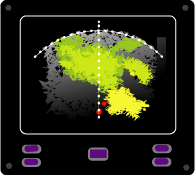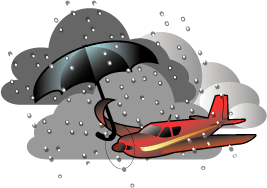 |
||||||||
| Issue Number 272 |
April
2002
|
|||||||
|
P.O. Box 189, Moffett Field, CA 94035-0189 |
||||||||
|
|
||||||||
 |
||||||||
| Issue Number 272 |
April
2002
|
|||||||
|
P.O. Box 189, Moffett Field, CA 94035-0189 |
||||||||
|
|
||||||||
"TERRAIN, TERRAIN - Pull Up!"
 A
Minimum Safe Altitude (MSA) is defined by 14 CFR Part 91.119(a) as
"an altitude allowing, if a power unit fails, an emergency landing
without undue hazard to persons or property on the surface."
A
Minimum Safe Altitude (MSA) is defined by 14 CFR Part 91.119(a) as
"an altitude allowing, if a power unit fails, an emergency landing
without undue hazard to persons or property on the surface."
The minimum altitudes depicted on approach charts provide at least 1,000 feet of obstacle clearance for emergency use within a specified distance from the navigation facility upon which a procedure is based. As a First Officer discovered, a night approach into an airport located in mountainous terrain requires good crew coordination and compliance with charted altitude minimums:
1 Controller, 3 Emergencies
An instrument-rated General Aviation pilot encountered unforecast IMC and a lower ceiling than he felt confident handling under IFR flight. Unfortunately, this emergency was not the only one being handled by ATC.
Wanted GPWS: Gear Pin Warning System
A maintenance technician reports to ASRS that creative substitutes for maintenance manual procedures may cause their own set of problems:
April Showers
"Spring is showery, flowery, bowery"
As some of our readers may know, April is National Poetry Month. In recognition of this annual cultural event, CALLBACK offers the following acrostic poem and several recent ASRS reports on incidents involving lowering weather and
Resourceful
Aviators
In
Need of
Safer procedures.
The Artful (Weather) Dodger
A GA pilot was repositioning an aircraft with no radios on a long cross-country flight. He was prepared for forecast rain showers, but not for worsening visibility.
This pilot might also have planned a fuel stop for the trip, which would have allowed time for a weather update and needed fuel reserves. A handheld transceiver would have provided communications capability for an emergency.
Short Flight, Long Landing
A GA pilot was anxious to return a vintage radial-engine military trainer to his home base. But a line of thunderstorms was quickly moving into the area:
I was attempting to make a short 30-mile flight to return to my home base. There was a line of thunderstorms moving towards us from the west. My route of flight was due south. After takeoff and flying south for 5 minutes, it became apparent that we would not be able to continue because rain showers had moved into that area. I turned around and headed back. The winds had been out of the south all day, so I re-entered the downwind for Runway 16. The winds were beginning to get gusty from the approaching thunderstorm. On final approach, the winds were requiring considerable right crab indicating stronger winds from the west. I landed 1,000 feet from the approach end of Runway 16, which is 3,800 feet long. Just as I touched down, we were hit from the rear by a very strong gust front of the approaching thunderstorm. The microburst and resulting windshear were recorded at 50 mph. With the strong tailwind on the runway, I was unable to stop the aircraft and feared doing a go-around in a potentially unsurvivable windshear condition. We impacted the fence off the end of the runway. There were no injuries [and] the aircraft sustained minor damage.
I should have delayed the flight until the thunderstorms had moved through the area. On my return, I should have considered the possibility of windshear and diverted to a field which was further away from the approaching storm.
Tail Feather Trespass
Just when we thought we'd read it all, we received this report describing how one pilot got the attention of another (not recommended, we should add):
Both pilots came up short on safety and etiquette in this incident. The Cessna pilot failed to observe what was around the airplane before starting the run-up. The elevator-lifting reporter could have been injured or caused damage to the Cessna.
| ASRS Recently Issued Alerts On... |
|---|
| An ATC clearance-related runway conflict |
| EMB 145 pitch trim failure during initial climb |
| A severe runway conflict involving a B767 and A321 |
| CL-65 frozen aileron stabilizer trim incident at FL240 |
| DHC8-100 aileron control wheel disconnect on landing |
|
February
2002 Report Intake
|
|
|---|---|
| Air Carrier/Air Taxi Pilots |
1,856
|
| General Aviation Pilots |
678
|
| Controllers |
28
|
| Cabin/Mechanics/Military/Other |
97
|
| TOTAL |
2,659
|